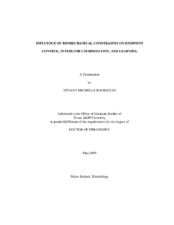| dc.description.abstract | A number of movements produced in everyday life require not only coordination of joints within a limb, but also coordination between one or more limbs. The aim of this dissertation was to examine the influence of biomechanical constraints on intralimb coordination, interlimb coordination, and learning. Experiment 1 sought to determine if principles of the Leading Joint Hypothesis, when applied to a multijoint bimanual coordination task, could provide insight into the contribution of intralimb dynamics to interlimb coordination. Participants repetitively traced ellipse templates in an asymmetrical coordination pattern (i.e. both limbs moving counter-clockwise). Kinematic data of the upper limbs were recorded with a VICON camera system. Ellipse templates were oriented either tilted right or tilted left; yielding a total of four left arm-right arm leading joint combinations. The findings indicated that stability of interlimb coordination patterns were found to be influenced by whether arm movements were produced with similar or different leading joints. Bimanual asymmetric ellipse-tracing produced with similar leading joints were more stable than patterns produced with different leading joints. For example, asymmetric coordination patterns produced with similar leading joints exhibited less transient behavior than coordination patterns produced with different leading joints (p < .01). Experiment 2 expanded on these findings by employing a similar task and incorporating a learning component to assess how intralimb dynamics are tuned with practice of a novel coordination pattern. Participants were randomly assigned to one of three groups. One group practiced tracing a pair of ellipse templates that were oriented in such a way that required similar leading joints while the other two groups practiced tracing ellipse templates that required different leading joints. Early in practice, the group learning the coordination pattern with similar leading joints exhibited greater interlimb stability than the two groups learning with different leading joints. However, following two days of practice, performance of the groups learning with different leading joints improved to match that of the group learning with similar leading joints. The findings suggest that initial biomechanical constraints can be overcome with practice, resulting in similar performance regardless of whether being produced with similar or different leading joints. | en |


